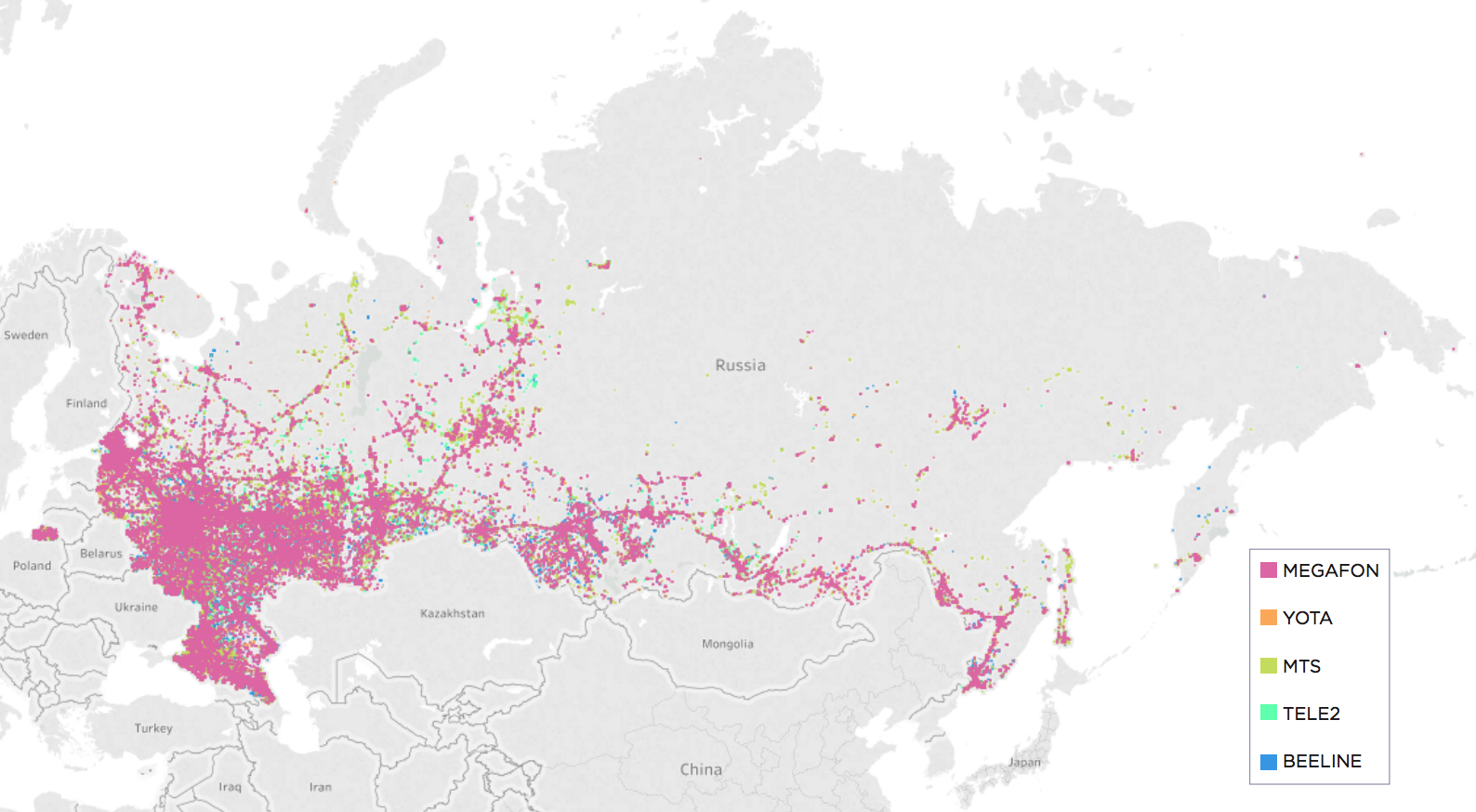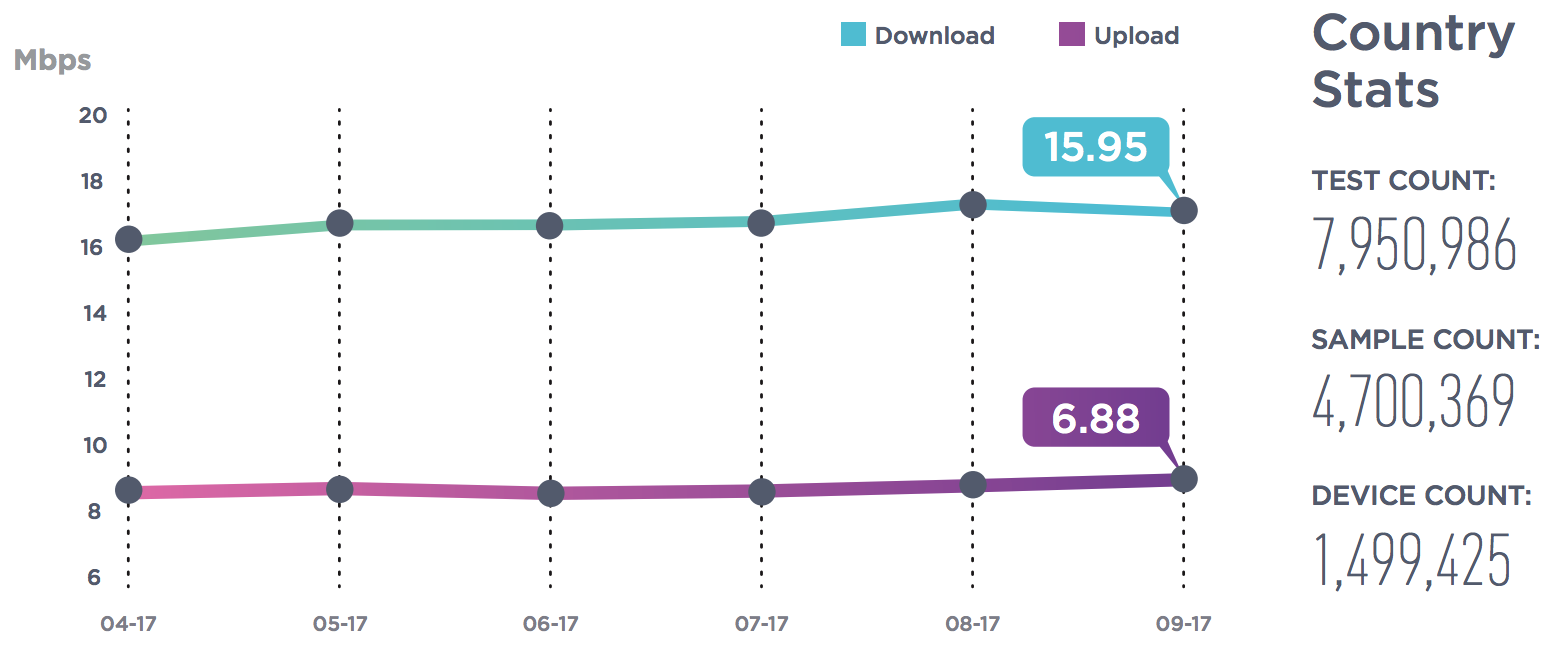How the creators of Speedtest evaluate mobile Internet in Russia
The American company Ookla is known from us for its Speedtest application, the most popular mobile internet speed meter. For the second or third quarter of 2017, the developers collected about 1-1.5 million tests for each of the major Russian mobile Internet operators, and then based on this data they conducted a study and a comparison of speed. How all this is organized, we will tell under the cut.

In the study, Ookla took into account only "modern devices". Not the most clear wording. Ookla explains: “devices capable of reaching the highest speeds available in the country”. Cleared slightly. Actually we mean devices with LTE support. 6,302,071 passed through this filter from 7,950,986 total measurements across the country.
')
To begin with - the final picture, after which we analyze the method.

Seats were distributed on the basis of the indicator Speed Score. It is 90% dependent on the download speed (download trimean column) and 10% on the download speed (upload trimean column). Researchers have taken this as the standard ratio of mobile traffic flows.

All numbers are not abstract, they are concrete megabits per second.
How to get "trimeans" of millions of numbers? Ookla divided the operator data and calculated for each array the 10th percentile, the 50th percentile (median) and the 90th percentile. And then, based on them, I took the arithmetic average weighted in proportions of 1: 2: 1 (more weight behind the median). The result is on the color scales of the final rating.

There is also a simpler table, where average speeds are calculated. Sample Count is the number of "sessions" (measurements during the day at user X in location Y with provider Z). Test Count is the total number of measurements.

The map of the collected measurements is not surprising: mainly the western and southwestern regions
MegaFon's leadership in the independent study of Ookla is supported by data from another independent agency, TelecomDaily - at least in Moscow and St. Petersburg . The first place can be explained by a large number of base stations compared to other operators (which confirms the study of Roskomnadzor). As well as using the frequency band at 2x40 MHz in LTE Band 7, while all competitors use 2x10 MHz.

In addition to counting LTE devices, Ookla introduced the general temperature at the hospital. From it, we learn that Speedtest for the testing period (2-3 quarter of 2017) used almost 1.5 million devices in Russia.
If we estimate the speed of the mobile Internet in the world, then Russia occupies the 72nd place in this rating. This rating also leads Ookla, it now lists 123 countries. In the top three - Norway, Malta and the Netherlands. Close the hit parade of Bangladesh, Libya and Iraq. The good news is that since the beginning of 2017 in Russia the number of base stations with LTE has increased by 45%. There is every chance to rise to higher positions.

In the study, Ookla took into account only "modern devices". Not the most clear wording. Ookla explains: “devices capable of reaching the highest speeds available in the country”. Cleared slightly. Actually we mean devices with LTE support. 6,302,071 passed through this filter from 7,950,986 total measurements across the country.
')
To begin with - the final picture, after which we analyze the method.

Seats were distributed on the basis of the indicator Speed Score. It is 90% dependent on the download speed (download trimean column) and 10% on the download speed (upload trimean column). Researchers have taken this as the standard ratio of mobile traffic flows.

All numbers are not abstract, they are concrete megabits per second.
How to get "trimeans" of millions of numbers? Ookla divided the operator data and calculated for each array the 10th percentile, the 50th percentile (median) and the 90th percentile. And then, based on them, I took the arithmetic average weighted in proportions of 1: 2: 1 (more weight behind the median). The result is on the color scales of the final rating.

There is also a simpler table, where average speeds are calculated. Sample Count is the number of "sessions" (measurements during the day at user X in location Y with provider Z). Test Count is the total number of measurements.

The map of the collected measurements is not surprising: mainly the western and southwestern regions
MegaFon's leadership in the independent study of Ookla is supported by data from another independent agency, TelecomDaily - at least in Moscow and St. Petersburg . The first place can be explained by a large number of base stations compared to other operators (which confirms the study of Roskomnadzor). As well as using the frequency band at 2x40 MHz in LTE Band 7, while all competitors use 2x10 MHz.

In addition to counting LTE devices, Ookla introduced the general temperature at the hospital. From it, we learn that Speedtest for the testing period (2-3 quarter of 2017) used almost 1.5 million devices in Russia.
If we estimate the speed of the mobile Internet in the world, then Russia occupies the 72nd place in this rating. This rating also leads Ookla, it now lists 123 countries. In the top three - Norway, Malta and the Netherlands. Close the hit parade of Bangladesh, Libya and Iraq. The good news is that since the beginning of 2017 in Russia the number of base stations with LTE has increased by 45%. There is every chance to rise to higher positions.
Source: https://habr.com/ru/post/347554/
All Articles